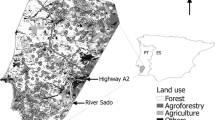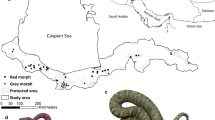Abstract
Spatial heterogeneity can constrain the movement of individuals and consequently genes across a landscape, influencing demographic and genetic processes. In this study, we linked information on landscape composition, movement behavior, and genetic differentiation to gain a mechanistic understanding of how spatial heterogeneity may influence movement and gene flow of bobcats in the agricultural landscape of Iowa (USA). We analyzed movement paths of 23 animals to parameterize landscape resistance surfaces, applied least cost path analysis to generate measures of effective geographic distance between DNA collection locations of 625 bobcats, and tested the correlation between genetic distance and the different models of geographic distance. We found that bobcats showed a strong preference for forest over any other habitat type, and that incorporating information on habitat composition both along the path and in the surrounding landscape provided the best model of movement. Measures of effective geographic distance were significantly correlated with genetic distance, but not once the effects of Euclidean distance were accounted for. Thus, despite the impact of habitat composition on movement behavior, we did not detect a signature of a landscape effect in genetic structure. Our results are consistent with the issue of limiting factors: the high uniformity of forest fragmentation across southern Iowa, the primary study area, results in a landscape resistance pattern virtually indistinguishable from the isolation-by-distance pattern. The northern portion of the state, however, is predicted to pose a high level of resistance to bobcat movement, which may impede the regional genetic connectivity of populations across the Midwest.





Similar content being viewed by others
References
Abdi H, Williams LJ (2010) Jackknife. In: Salkind NJ, Dougherty DM, Frey B (eds) Encyclopedia of research design. Sage, Thousand Oaks, pp 655–660
Adriaensen F, Chardon JP, De Blust G, Swinnen E, Villalba S, Gulinck H, Matthysen E (2003) The application of ‘least-cost’ modelling as a functional landscape model. Landscape Urban Plan 64:233–247
Anderson CD, Epperson BK, Fortin MJ, Holderegger R, James PMA, Rosenberg MS, Scribner KT, Spear S (2010) Considering spatial and temporal scale in landscape-genetic studies of gene flow. Mol Ecol 19:3565–3575
Beier P, Majka DR, Spencer WD (2008) Forks in the road: choices in procedures for designing wildland linkages. Conserv Biol 22:836–851
Belsey DA, Kuh E, Welsch RE (1980) Regression diagnostics. Wiley, New York
Boutin-Ganache I, Raposo M, Raymond M, Deschepper CF (2001) M13-tailed primers improve the readability and usability of microsatellite analyses performed with two different allele-sizing methods. Biotechniques 31:24–28
Bruggeman JE, Garrott RA, White PJ, Watson FGR, Wallen R (2007) Covariates affecting spatial variability in bison travel behavior in Yellowstone National Park. Ecol Appl 17:1411–1423
Burnham KP, Anderson DR (2002) Model selection and multimodel inference: a practical information-theoretic approach. Springer, New York
Carmichael LE, Clark W, Strobeck C (2000) Development and characterization of microsatellite loci from lynx (Lynx canadensis), and their use in other felids. Mol Ecol 9:2197–2198
Corander J, Siren J, Arjas E (2008) Bayesian spatial modeling of genetic population structure. Comput Stat 23:111–129
Coulon A, Cosson JF, Angibault JM, Cargnelutti B, Galan M, Morellet N, Petit E, Aulagnier S, Hewison AJ (2004) Landscape connectivity influences gene flow in a roe deer population inhabiting a fragmented landscape: an individual-based approach. Mol Ecol 13:2841–2850
Coulon A, Morellet N, Goulard M, Cargnelutti B, Angibault JM, Hewison AJM (2008) Inferring the effects of landscape structure on roe deer (Capreolus capreolus) movements using a step selection function. Landscape Ecol 23:603–614
Cushman SA, Landguth EL (2010a) Scale dependent inference in landscape genetics. Landscape Ecol 25:967–979
Cushman SA, Landguth EL (2010b) Spurious correlations and inference in landscape genetics. Mol Ecol 19:3592–3602
Cushman SA, Lewis JS (2010) Movement behavior explains genetic differentiation in American black bears. Landscape Ecol 25:1613–1625
Cushman SA, McKelvey KS, Hayden J, Schwartz MK (2006) Gene flow in complex landscapes: testing multiple hypotheses with causal modeling. Am Nat 168:486–499
Cushman SA, Raphael MG, Ruggiero LF, Shirk AS, Wasserman TN, O'Doherty EC (2011) Limiting factors and landscape connectivity: the American marten in the Rocky Mountains. Landscape Ecol 26:1137–1149
Cushman SA, Shirk A, Landguth EL (2012a) Separating the effects of habitat area, fragmentation and matrix resistance on genetic differentiation in complex landscapes. Landscape Ecol 27:369–380
Cushman SA, Shirk AJ, Landguth EL (2012b) Landscape genetics and limiting factors. Conserv Genet. doi: 10.1007/s10592-012-0396-0
Deems EF Jr, Pursley D (1978) North American furbearers: their management, research, and harvest status in 1976. International Association of Fish and Wildlife Agencies, Washington, DC
Etherington TR (2011) Python based GIS tools for landscape genetics: visualizing genetic relatedness and measuring landscape connectivity. Method Ecol Evol 2:52–55
Fahrig L, Nuttle WK (2005) Population ecology in spatially heterogeneous environments. In: Lovette GM, Jones CG, Turner MG, Weathers KC (eds) Ecosystem function in heterogeneous landscapes. Springer, New York, pp 95–118
Faircloth BC, Reid A, Valentine T, Eo SH, Terhune TM, Glenn TC, Palmer WE, Nairn CJ, Carroll JP (2005) Tetranucleotide, trinucleotide, and dinucleotide loci from the bobcat (Lynx rufus). Mol Ecol Notes 5:387–389
Gillies CS, Hebblewhite M, Nielsen SE, Krawchuk MA, Aldridge CL, Frair JL, Saher DJ, Stevens CE, Jerde CL (2006) Application of random effects to the study of resource selection by animals. J Anim Ecol 75:887–898
Gosselink T, Roberts S, Clark W, Reding D, Linde S (2011) Distribution and population dynamics of bobcats in Iowa. Final Report. State Wildlife Grant T-1-R-14. Iowa Department of Natural Resources, Des Moines, Iowa
Graves TA, Wasserman TN, Ribeiro MC, Landguth EL, Spear SF, Balkenhol N, Higgins CB, Fortin MJ, Cushman SA, Waits LP (2012) The influence of landscape characteristics and home-range size on the quantification of landscape-genetics relationships. Landscape Ecol 27:253–266
Hagerty BE, Nussear KE, Esque TC, Tracy CR (2011) Making molehills out of mountains: landscape genetics of the Mojave desert tortoise. Landscape Ecol 26:267–280
Hardy OJ, Vekemans X (2002) SPAGEDi: a versatile computer program to analyse spatial genetic structure at the individual or population levels. Mol Ecol Notes 2:618–620
Hosmer DW, Lemeshow S (2000) Applied logistic regression. Wiley, New York
Johnson SA, Walker HD, Hudson CM (2010) Dispersal characteristics of juvenile bobcats in south-central Indiana. J Wildlife Manage 74:379–385
Karieva PM, Shigesada N (1983) Analyzing insect movement as a correlated random walk. Oecologia 56:234–238
Keyghobadi N, Roland J, Strobeck C (1999) Influence of landscape on the population genetic structure of the alpine butterfly Parnassius smintheus (Papilionidae). Mol Ecol 8:1481–1495
Kimura M, Weiss GH (1964) The stepping stone model of population structure and the decrease of genetic correlation with distance. Genetics 49:561–576
Klug PE, Wisely SM, With KA (2011) Population genetic structure and landscape connectivity of the Eastern Yellowbelly Racer (Coluber constrictor flaviventris) in the contiguous tallgrass prairie of northeastern Kansas, USA. Landscape Ecol 26:281–294
Landguth EL, Cushman SA, Schwart MK, McKelvey KS, Murphy M, Luikart G (2010) Quantifying the lag time to detect barriers in landscape genetics. Mol Ecol 19:4179–4191
Latch EK, Boarman WI, Walde A, Fleischer RC (2011) Fine-scale analysis reveals cryptic landscape genetic structure in desert tortoises. PLoS ONE 6:e27794
Linde SA (2010) Predicting favorable habitat for bobcats (Lynx rufus) in Iowa. MS thesis, Iowa State University, Ames, IA
Manel S, Schwartz MK, Luikart G, Taberlet P (2003) Landscape genetics: combining landscape ecology and population genetics. Trends Ecol Evol 18:189–197
Manly BFJ, McDonald LL, Thomas D (2002) Resource selection by animals: statistical design and analysis for field studies. Kluwer, Boston
Mantel N (1967) Detection of disease clustering and a generalized regression approach. Cancer Res 27:209–220
Menotti-Raymond M, David VA, Lyons LA, Schäffer AA, Tomlin JF, Hutton MK, O’Brien SJ (1999) A genetic linkage map of microsatellites in the domestic cat (Felis catus). Genomics 57:9–23
Menotti-Raymond MA, David VA, Wachter LL, Butler JM, O’Brien SJ (2005) An STR forensic typing system for genetic individualization of domestic cat (Felis catus) samples. J Forensic Sci 50:1061–1070
Newby JR (2011) Puma dispersal ecology in the central Rocky Mountains. MS thesis, University of Montana, Missoula, MT
Oksanen J, Blanchet FG, Kindt R, Legendre P, O'Hara RB, Simpson GL, Solymos P, Stevens MHH, Wagner H (2010) vegan: community ecology package. R package version 1.17-5. Available at http://CRAN.R-project.org/package=vegan
Pullinger MG, Johnson CJ (2010) Maintaining or restoring connectivity of modified landscapes: evaluating the least-cost path model with multiple sources of ecological information. Landscape Ecol 25:1547–1560
Rice WR (1989) Analyzing tables of statistical tests. Evolution 43:223–225
Richard Y, Armstrong DP (2010) Cost distance modelling of landscape connectivity and gap-crossing ability using radio-tracking data. J Appl Ecol 47:603–610
Rousset F (2000) Genetic differentiation between individuals. J Evolution Biol 13:58–62
Rousset F (2008) GENEPOP’007: a complete re-implementation of the GENEPOP software for Windows and Linux. Mol Ecol Res 8:103–106
Schick RS, Loarie SR, Colchero F, Best BD, Boustany A, Conde DA, Halpin PN, Joppa LN, McClellan CM, Clark JS (2008) Understanding movement data and movement processes: current and emerging directions. Ecol Lett 11:1338–1350
Schwartz MK, Copeland JP, Anderson NJ, Squires JR, Inman RM, McKelvey KS, Pilgrim KL, Waits LP, Cushman SA (2009) Wolverine gene flow across a narrow climatic niche. Ecology 90:3222–3232
Short Bull RA, Cushman SA, Mace R, Chilton T, Kendall KC, Landguth EL, Schwartz MK, McKelvey K, Allendorf FW, Luikart G (2011) Why replication is important in landscape genetics: American black bear in the Rocky Mountains. Mol Ecol 20:1092–1107
Sork VL, Waits L (2010) Contributions of landscape genetics—approaches, insights, and future potential. Mol Ecol 19:3489–3495
Spear SF, Balkenhol N, Fortin MJ, McRae BH, Scribner K (2010) Use of resistance surfaces for landscape genetic studies: considerations for parameterization and analysis. Mol Ecol 19:3576–3591
Stevens VM, Verkenne C, Vandewoestijne S, Wesselingh RA, Baguette M (2006) Gene flow and functional connectivity in the natterjack toad. Mol Ecol 15:2333–2344
Storfer A, Murphy MA, Spear SF, Holderegger R, Waits LP (2010) Landscape genetics: where are we now? Mol Ecol 19:3496–3514
Taylor PD, Fahrig L, Henein K, Merriam G (1993) Connectivity is a vital element of landscape structure. Oikos 68:571–573
Tucker SA, Clark WR, Gosselink TE (2008) Space use and habitat selection by bobcats in the fragmented landscape of south-central Iowa. J Wildlife Manage 72:1114–1124
Turchin P (1998) Quantitative analysis of movement: measuring and modeling population redistribution in animals and plants. Sinauer Associates, Sunderland
Van Oosterhout C, Hutchinson WF, Wills DPM, Shipley P (2004) MICRO-CHECKER: software for identifying and correcting genotyping errors in microsatellite data. Mol Ecol Notes 4:535–538
Wasserman TN, Cushman SA, Schwartz MK, Wallin DO (2010) Spatial scaling and multi-model inference in landscape genetics: Martes americana in northern Idaho. Landscape Ecol 25:1601–1612
Weir BS (1996) Genetic data analysis II. Sinauer Associates, Sunderland
Weir BS, Cockerham CC (1984) Estimating F-statistics for the analysis of population-structure. Evolution 38:1358–1370
Wright S (1943) Isolation by distance. Genetics 28:114–138
Xian G, Homer C, Fry J (2009) Updating the 2001 National Land Cover Database land cover classification to 2006 by using Landsat imagery change detection methods. Remote Sens Environ 113:1133–1147
Zeller KA, McGarigal K, Whitely AR (2012) Estimating landscape resistance to movement: a review. Landscape Ecol 27:777–797
Acknowledgments
Funding was provided by State Wildlife Grant T-1-R-14, Iowa Department of Natural Resources, Iowa State University, and through a grant from the Iowa Science Foundation administered by the Iowa Academy of Science. We thank S. Tucker, J. Coffey, C. Tucker, D. Broman, J. Timmer, J. Kaufmann, C. Holy, and J. Comeau for field assistance; A. Bronikowski, E. Schroder, D. Fredrickson, H. Yoon, and K. Bellinger for laboratory assistance; J. Sherwood, R. McNeely, and J. Olbrecht for GIS assistance; K. Pazdernik for statistical assistance; and C. McAlpine and three anonymous reviewers for comments on a draft of this manuscript.
Author information
Authors and Affiliations
Corresponding author
Rights and permissions
About this article
Cite this article
Reding, D.M., Cushman, S.A., Gosselink, T.E. et al. Linking movement behavior and fine-scale genetic structure to model landscape connectivity for bobcats (Lynx rufus). Landscape Ecol 28, 471–486 (2013). https://doi.org/10.1007/s10980-012-9844-y
Received:
Accepted:
Published:
Issue Date:
DOI: https://doi.org/10.1007/s10980-012-9844-y




